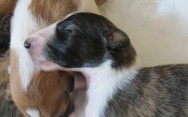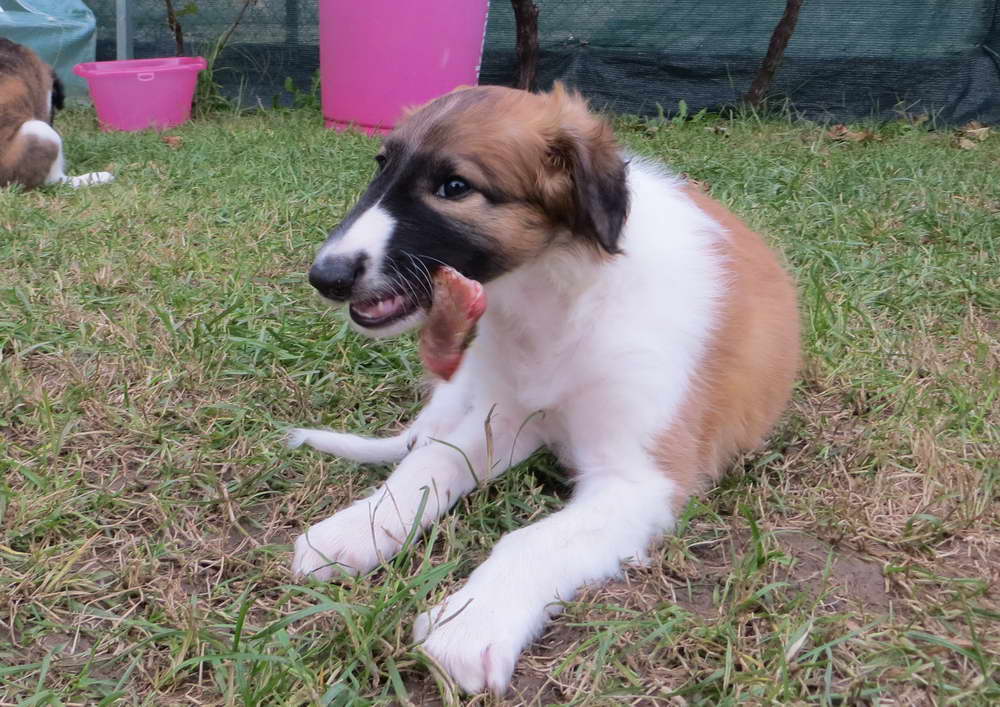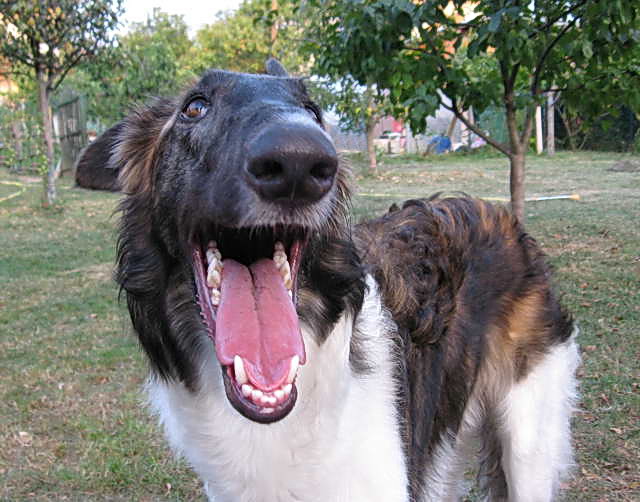History of the Borzoi breed
BORZOI …. dignified, elegant, independent and noble dog.
When I think of Borzoi, the first thing that appears in my mind is the picture of Tsar’s Russia and the vastness of that big country. Aristocrats are riding horses. By each rider walk few tall and strong dogs bright with passion. Their nostrils are expanding, their necks are elongated, all the muscles are stretched tight, and sometimes they raise their ears lurking for a sound. Their big eyes, the color of dark velvet, are scanning the horizon. They feel the tense of the hunt. And then they slice through the air with their slender bodies. After the rush the only thing that exists is the silence that holds the continuous gallop, the hard breath of horses and the squeaking saddle. With incredible speed and agility they hunt down their prey. They represent the perfect combination of harmony and efficiency.
After the war with Napoleon the sport activities have again recapitalized that days when Borzoi was just a hunting dog and his working abilities were major. Nobody cared how they looked like. Working on their improvement they inter-crossed them with another sort, so there remained only a small number of purebred Borzois. In 1824 Borzoi exhibited for the first time in Moscow. After that event, theirs look also becomes very important. They wanted to have a dog who is both excellent hunter and dog – show winner. Therefore inter-crossing with other dog breeds was stopped.
 In 1873, in Moscow was constituted the Society for the Development of Hunting Dogs. They organized exhibitions and interceded for Borzois body and hunting abilities improvement.
In 1873, in Moscow was constituted the Society for the Development of Hunting Dogs. They organized exhibitions and interceded for Borzois body and hunting abilities improvement.
In 1887 duke Nikolai Nikolayev’s Romanov bought the estate near village Pershino. Duke, as a passionate hunter, collected the fastest and the bravest greyhounds. He owned 160 Borzois, and he took a great care about them. His kennel Pershino became the most renowned in the western world. However her history began much earlier, when the Russian tsarina Cathrine has gifted the well known bank manager Lasarieff a big estate in the province of Tulsk. His son in law known as a big fan of hunt was first who started to breed Borzois on the estate. The following years that came had been full of both prosperity and poverty. The kennel Pershino will experience good progress during the reign of duke Nikolai. As the president of the Society for the Encouragement of Sport in 1889 he produced the Borzoi standard.
Other Russian nobles were also establishing kennels with lots of greyhounds. Depending on personal hunting ambitions of noble – owner, and depending on the “western” imported dogs, which were used to mate with their own dogs, originated different types of Borzois, which were named by the names of kennels. The vastness of the country contributed to the varieties in the breed. The distances between the estates were great and every kennel was like island in a ocean. Thanks to a few breeders the native type of Borzoi was preserved to the end of 19th century, and their attributes have become more determined. Two of the bigger kennels, Gustopsovoy i Christopsovoy, exchanged the dogs and together raised the unique type – which are Borzois as we know them today. According to the logs and notations there were seven big kennels at the end of 19th century: The most renowned and popular was the Pershino breeder and the others were: Oseroff, Boldereff, Tschelischtscheff, Sumarokoff, Gejeroff and Bibikoff.
The breed soon recovered and that part of history was maybe the most fortunate period of their existing. They had lived the life for which they were created – the life of hunter. They represented a big treasure which could be owned only by nobility. It was unthinkable to sell them or buy them. Borzois were gifted to loyal people of the empire or were gifted as an expensive gift to the crowned heads of Europe.
They lived in better conditions than the most of the Russian population at the time. They were aristocratic dogs. Alleged; till the 1918, there was a legal act which provided death penalty for illegal ownership of Borzois. Nobility was strongly against illegal hunting on their estates, especially by using the dog as perfect as Borzoi. In 1904 the Russian – Japanese war had began. Failures and big victims in that war had accelerated revolutionary expansion through decades of accumulated disappointments. In 1905 began the first bourgeoisies-democratic revolution and nine years after the First World War (1914-1918).The archaic economy of Imperial Russia could not satisfy the needs of the Russian army. The exhausted country had approached to the total catastrophe. Bourgeoisie had made beneficial acts using the war situations. The attitude of workers was suddenly changed. All those disappointments of imperial regime made a revolutionary situation in the country. In 1917 and 1918 a democratic revolution proceeded in the proletarian revolution. For the first time on a sixth part of a planet Earth, in a Big October, has been realized the dictatorship of proletarians.
In 1904 the Russian – Japanese war had began. Failures and big victims in that war had accelerated revolutionary expansion through decades of accumulated disappointments. In 1905 began the first bourgeoisies-democratic revolution and nine years after the First World War (1914-1918).The archaic economy of Imperial Russia could not satisfy the needs of the Russian army. The exhausted country had approached to the total catastrophe. Bourgeoisie had made beneficial acts using the war situations. The attitude of workers was suddenly changed. All those disappointments of imperial regime made a revolutionary situation in the country. In 1917 and 1918 a democratic revolution proceeded in the proletarian revolution. For the first time on a sixth part of a planet Earth, in a Big October, has been realized the dictatorship of proletarians.  Nobility disappeared in Russia. It was a big tragedy for humans and animals. Everything associated on aristocracy was destroyed. Most of the kennels disappeared, and a small part of aristocracy has succeeded to flee with their dogs in Europe, mostly in Holland. Some of Borzois escaped to the woods and became wild. Most of them were killed by the furious revolutionary soldiers. The breed was again at the beginning of extinction. In 1920 the whole Russia had just a few sections of purebred Borzois, in Moscow and St. Petersburg. Fortunately the communist reign admitted Chelischev, Sumarokov and Mamontov to save their dogs. They continued their work in national kennels. They started from nothing but they managed to save the breed. Today in Russia there are around 2000 Borzois with authentic pedigree.
Nobility disappeared in Russia. It was a big tragedy for humans and animals. Everything associated on aristocracy was destroyed. Most of the kennels disappeared, and a small part of aristocracy has succeeded to flee with their dogs in Europe, mostly in Holland. Some of Borzois escaped to the woods and became wild. Most of them were killed by the furious revolutionary soldiers. The breed was again at the beginning of extinction. In 1920 the whole Russia had just a few sections of purebred Borzois, in Moscow and St. Petersburg. Fortunately the communist reign admitted Chelischev, Sumarokov and Mamontov to save their dogs. They continued their work in national kennels. They started from nothing but they managed to save the breed. Today in Russia there are around 2000 Borzois with authentic pedigree.
Borzoi, the magnificent dog bred only for hunting, with a perfect body for that purpose, these days does not hunt almost anywhere. A dog which was not bred as a pet, unaccustomed to pampering, complete individual, has become a dog only for exhibitions. The looks are the most important thing. Today the breed is again endangered.











